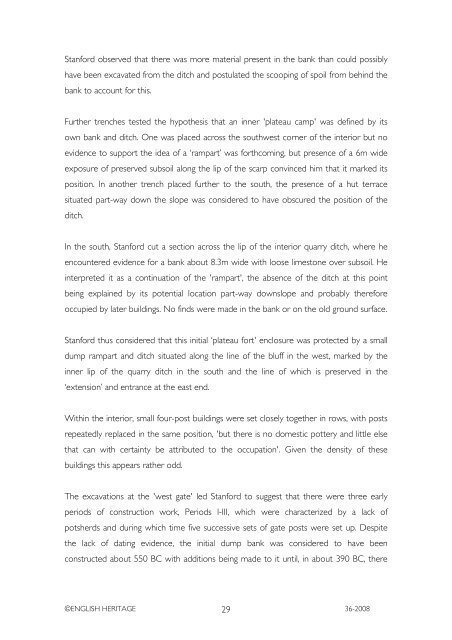CROFT AMBREY, AYMESTREY ... - English Heritage
CROFT AMBREY, AYMESTREY ... - English Heritage
CROFT AMBREY, AYMESTREY ... - English Heritage
You also want an ePaper? Increase the reach of your titles
YUMPU automatically turns print PDFs into web optimized ePapers that Google loves.
Stanford observed that there was more material present in the bank than could possibly<br />
have been excavated from the ditch and postulated the scooping of spoil from behind the<br />
bank to account for this.<br />
Further trenches tested the hypothesis that an inner 'plateau camp' was defined by its<br />
own bank and ditch. One was placed across the southwest corner of the interior but no<br />
evidence to support the idea of a ‘rampart’ was forthcoming, but presence of a 6m wide<br />
exposure of preserved subsoil along the lip of the scarp convinced him that it marked its<br />
position. In another trench placed further to the south, the presence of a hut terrace<br />
situated part-way down the slope was considered to have obscured the position of the<br />
ditch.<br />
In the south, Stanford cut a section across the lip of the interior quarry ditch, where he<br />
encountered evidence for a bank about 8.3m wide with loose limestone over subsoil. He<br />
interpreted it as a continuation of the 'rampart', the absence of the ditch at this point<br />
being explained by its potential location part-way downslope and probably therefore<br />
occupied by later buildings. No finds were made in the bank or on the old ground surface.<br />
Stanford thus considered that this initial ‘plateau fort' enclosure was protected by a small<br />
dump rampart and ditch situated along the line of the bluff in the west, marked by the<br />
inner lip of the quarry ditch in the south and the line of which is preserved in the<br />
‘extension’ and entrance at the east end.<br />
Within the interior, small four-post buildings were set closely together in rows, with posts<br />
repeatedly replaced in the same position, 'but there is no domestic pottery and little else<br />
that can with certainty be attributed to the occupation'. Given the density of these<br />
buildings this appears rather odd.<br />
The excavations at the 'west gate' led Stanford to suggest that there were three early<br />
periods of construction work, Periods I-III, which were characterized by a lack of<br />
potsherds and during which time five successive sets of gate posts were set up. Despite<br />
the lack of dating evidence, the initial dump bank was considered to have been<br />
constructed about 550 BC with additions being made to it until, in about 390 BC, there<br />
©ENGLISH HERITAGE 29<br />
36-2008

















